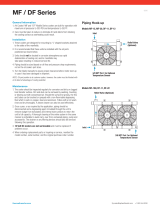
9
2.0 PIPING
2.1 Split Air Cooled Unit Piping
Refer to the attached line sizing chart on page 31 for a guideline for sizing refrigerant lines. The
ultimate responsibility for line size selection is that of the installing contractor or project engineer.
Data Aire does not assume this responsibility. The chart covers distances up to 200 equivalent feet.
For installations greater than this distance, consult ASHRAE or similar references.
Standard piping practice must be used to ensure proper oil return and effi cient operation.
The interconnecting lines to the remote air cooled condenser or condensing unit must
be installed by a qualifi ed refrigeration mechanic.
2.1.1 Discharge Lines
Discharge lines, also called hot gas lines, should be trapped at the top (inverted) and bottom, as well
as every 20 feet of vertical rise. Discharge line check valves are recommended on all installations,
especially those where there are long pipe runs or cold climate. Check valves should be installed no
less than six feet from the compressor. The discharge, suction and liquid lines need to be refrigerant
grade copper and in accordance with local code. All refrigeration piping should be installed with
high temperature brazed joints. When brazing, a supply of nitrogen gas needs to be fed through the
refrigerant lines. Be sure to open the other end of the refrigerant line to allow the nitrogen to bleed
off and not pressurize the piping. Prevailing good refrigeration practices should be employed for
piping support, leak testing, dehydration and charging of the refrigerant circuits. During the installation
the lines should be capped off and fi lled with dry nitrogen at the end of each day’s work or until the
system is completed and sealed.
Data Aire recommends a silver/phosphorus/copper alloy with 5 to 15% silver be used to braze the
refrigerant line sets to the indoor and outdoor units. Nitrogen needs to be fl owing through the lines to
eliminate carbon deposit buildup on the inside of the joints. Carbon could contaminate the refrigerant
and restrict the metering device.
Piping must be supported within 18” of the inlet and outlet connections. The inlet connection is located
on the top header of all units. The discharge outlet is located at the bottom of the header.
Discharge line pressure drop should not exceed 6 PSI for R-407c and 9 PSI for R-410a. Recommended
gas velocity for proper oil return is 1,000 FPM. Slope horizontal lines downward in the direction of
refrigerant fl ow, 1/2” for every ten feet of line length. Discharge lines do not require insulation but
due to the high temperatures of the refrigerant inside the line, the pipes may be insulated to protect
against burns to individuals near or around the lines.
2.1.2 Liquid Lines
Liquid line size is determined by pressure drop and velocity. The liquid line pressure drop for R-407c
should not exceed 5 PSI or 9 PSI for R-410a. The recommended velocity should be between 200
and 300 FPM. To avoid excessive liquid line pressure drop, the air cooled condenser should be
located above or at the same level as the evaporator. Condenser installation more than ten feet
below the evaporator is not recommended. Insulation of liquid lines is not required but can be useful
in preventing condensation from forming and to avoid fl ashing on long pipe runs.
2.1.3 Suction Lines
Some applications call for the compressor(s) to be mounted as part of the condenser, more commonly
referred to as a condensing unit. Such cases require fi eld piping of liquid and suction lines. Suction
lines are trapped similarly to discharge lines. Common practice for suction line selection and
installation should be followed. Suction lines should always be insulated.























